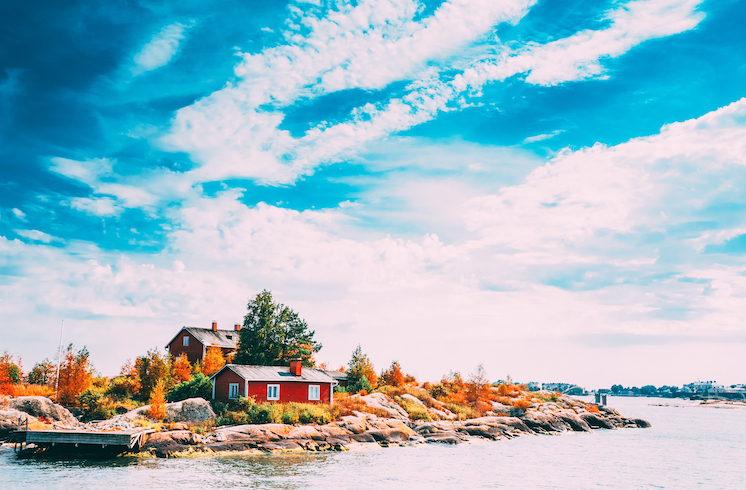Is Finland Safe?
Coronavirus (COVID-19) and travel: The situation around the world is changing dramatically. Various governments have changed their travel warnings to restrict travel during this time. To understand how this may impact cover under your policy, please go to our FAQs and select your country of residence.
For the latest travel warnings and alerts around the world, read about lockdowns and border restrictions.
The northern European country of Finland is known for its icy north as well as its more than 40,000 islands. Here's how to explore it safely.
Shares
 Photo © Getty Images/Henryk Sadura
Photo © Getty Images/Henryk Sadura
Finland sounds like Utopia with its natural wonders, clean air and water. It’s also known for its low crime rate, ranked as the world’s safest country in 2019 by the World Economic Forum. Here’s what you need to know to get the best out of your time in Finland.
Climate and weather
Finland’s climate is extreme with freezing winters and warm sunny summers. Winter usually begins in mid-October in Lapland in the far north, and November in the rest of Finland, and December in the southwestern archipelago. Winter is the longest season in Finland and last for about 100 days in southwestern Finland and 200 days in Lapland.
In winter, North of the Arctic Circle, the sun does not rise above the horizon for 51 days. In southern Finland, the shortest day is about 6 hours long.
Permanent snow covers open grounds about two weeks after winter begins with the snow at its is deepest in mid-March, averaging 60 to 90 cm of snow in eastern and northern Finland and 20 to 30 cm in southwestern Finland. The lakes freeze over in late November and early December with the ice at its thickest in early April, at about 50 to 65 cm. The coldest temperatures in winter are from -45°C to -50°C in Lapland and eastern Finland; from -35°C to -45°C elsewhere; and -25°C to -35°C in island and coastal areas. The lowest temperature recorded in Finland was -51.5°C in 1999.
In summer, which runs from May until September, regions north of the Arctic Circle experience polar days, when the sun does not set for 73 days every year and the longest day is nearly 19 hours long. Temperatures in the Finnish interior are from 32°C to 35°C. Near the sea and over the islands, temperatures above 30°C are rare. The highest temperature recorded was 37.2°C in July 2021.

Island Near Helsinki, Finland. Photo credit: Getty Images / Bruev
Getting around
Finland's transport systems are well connected and it’s easy to get around by plane, bus, car, train, boat, bicycle, skis or sleigh.
For bus timetables, visit www.matkahuolto.fi, for trains go to www.vr.fi. A good online journey planner is www.journey.fi.
Bus routes criss-cross the country, run on time, and rarely require bookings but are slower than trains, which are well-run and comfortable but do require bookings. Internal flights are expensive but multi-trip journeys can be better value. Some Lapland destinations are only available in winter.
Finland is very bike-friendly with many routes and easy flat terrain. You can take bikes on most trains, buses and ferries. Helmets are the safest option but are not compulsory by law. Bikes are easy to hire in most towns and at campgrounds and hotels.
Lake boats were once important summer transport providers. These services are now largely kept on as cruises, and make a great, leisurely way to journey between towns. The most popular routes are Tampere–Hämeenlinna, Tampere–Virrat, Savonlinna–Kuopio and Lahti–Jyväskylä.
Coastal routes include Turku–Naantali, Helsinki–Porvoo and ferries to the Åland Archipelago.
This website is handy for domestic lake-boat and ferry services.
Driving in Finland
Roads in Finland are in good condition. Driving is on the right side, and drivers must be at least 18 and have a valid driver's license, and all passengers must wear seat belts. Headlights must be used at all times. The speed limits are 50km’h in built-up areas and 80km/h on other roads. On major highways, the limits are 100 km/h in the summer and 120 km/h on motorways. In winter the general speed limit is reduced everywhere to 80 km/h.
Winter driving in Finland can be dangerous; daylight hours are short and icy roads are common. All vehicles must have snow tires (or M/S rated) between December and February. At night, drivers must look out for moose, elk, and reindeer wandering onto roads; a collision with a moose can right off a vehicle or result in the death of the occupants.
Always carry your car insurance documents with you in case of an accident. Finnish laws for drink-driving are extremely strict; driving with a blood-alcohol content (BAC) level at or above 0.05% is illegal.
Car hire is widely available, but you must have a credit card. Booking in advance tends to result in better deals.
Swimming in Finland
Finland has more than 300 public beaches, 190,000 lakes, and 2,850mi (4,600 km) of coastline so swimming is a popular pastime, particularly during the long summer days and nights. Ice swimming is also popular in winter with around 150,000 Fins enjoying taking the icy plunge on a regular basis. Always swim with other people, preferably at beaches and lakes with lifeguards, and obey safety signs.
In any emergency, call 112.
Get a travel insurance quote for Finland
You can buy at home or while traveling, and claim online from anywhere in the world. With 150+ adventure activities covered and 24/7 emergency assistance.
Related articles
Simple and flexible travel insurance
You can buy at home or while traveling, and claim online from anywhere in the world. With 150+ adventure activities covered and 24/7 emergency assistance.
Get a quote



No Comments